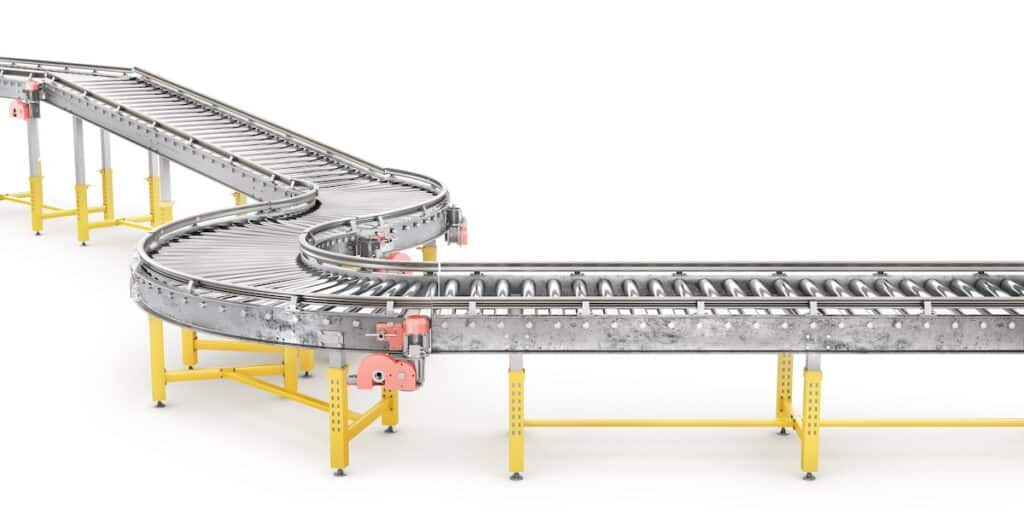Discover how conveyor systems revolutionize warehouse operations, optimizing efficiency and productivity.
The Role of Conveyor Systems in Streamlining Warehouse Operations
Conveyor systems play a crucial role in the smooth functioning of warehouse operations. These systems are designed to efficiently transport materials or products within a warehouse, streamlining the entire process and improving productivity. By automating the movement of goods, conveyor systems enable warehouses to handle larger volumes of inventory with ease, resulting in increased efficiency and reduced operational costs.
Understanding Conveyor Systems
Before delving into the benefits offered by conveyor systems, it is important to have a clear understanding of how they work. Conveyor systems consist of several basic components that work together seamlessly to facilitate the movement of goods.
Conveyor systems play a crucial role in the efficiency of various industries, from manufacturing to distribution centers. By automating the process of moving goods from one point to another, conveyor systems help streamline operations and increase productivity. Understanding the intricacies of conveyor systems can provide valuable insights into optimizing workflow and enhancing overall efficiency.
Basic Components of Conveyor Systems
Conveyor systems consist of belts, rollers, motors, and control systems. The conveyor belts are the primary mechanism for transporting goods and can be configured to accommodate different types of materials. The rollers provide support and guidance for the belts, ensuring smooth movement. Motors power the belts, allowing for controlled and efficient transportation. Control systems monitor the speed and direction of the belts, ensuring optimal performance.
Each component of a conveyor system plays a vital role in ensuring the seamless operation of the system. From the precision engineering of the belts to the sophisticated control systems that regulate movement, every aspect is designed to work in harmony. Understanding how each component interacts with the others can help in troubleshooting and maintaining conveyor systems for long-term reliability.
Types of Conveyor Systems
There are several types of conveyor systems available, each designed to suit specific warehouse needs. Common types include gravity roller conveyors, belt conveyors, and flexible conveyors. Gravity roller conveyors rely on the force of gravity to move items, while belt conveyors use rotating belts to transport goods. Flexible conveyors allow for easy customization and can be adjusted to fit different warehouse layouts and requirements.
Choosing the right type of conveyor system is essential for optimizing workflow and maximizing space utilization in a warehouse or manufacturing facility. Understanding the unique features and benefits of each type of conveyor system can help businesses make informed decisions when investing in material handling equipment. By selecting the most suitable conveyor system for their specific needs, companies can improve efficiency and reduce operational costs in the long run.

The Importance of Streamlining Warehouse Operations
Efficiency is a key aspect of successful warehouse operations. Streamlining the various processes involved in storing and moving inventory not only saves time and resources but also improves customer satisfaction.
Efficient warehouse operations are crucial for businesses looking to stay competitive in today’s fast-paced market. By optimizing workflows and reducing unnecessary steps, companies can ensure that their products are delivered to customers in a timely manner, leading to increased customer satisfaction and loyalty.
Enhancing Efficiency in Warehouse Operations
By integrating conveyor systems into warehouse operations, businesses can significantly enhance efficiency. Conveyor systems eliminate the need for manual transportation of goods, allowing employees to focus on other important tasks. This streamlined process minimizes bottlenecks and reduces the time required to complete tasks, leading to improved efficiency and productivity.
Furthermore, the implementation of advanced technologies such as RFID tracking and automated inventory management systems can further streamline warehouse operations. These technologies enable real-time tracking of inventory, reducing the likelihood of stockouts and improving inventory accuracy. By leveraging these tools, businesses can optimize their warehouse space and improve order fulfillment processes.
Reducing Operational Costs
Warehouse operations can be costly, especially when manual labor is involved. Conveyor systems offer a cost-effective solution by reducing the need for extensive manual labor. With automated material handling, warehouses can optimize their resources and allocate their workforce to more strategic activities. This not only reduces labor costs but also minimizes the risk of errors and damage to goods, resulting in overall cost savings.
Moreover, by implementing energy-efficient lighting and heating systems, warehouses can further reduce operational costs. Energy-efficient solutions not only lower utility bills but also contribute to a more sustainable and environmentally friendly operation. By investing in sustainable practices, businesses can reduce their carbon footprint and appeal to environmentally conscious consumers.

How Conveyor Systems Improve Warehouse Operations
Conveyor systems bring numerous benefits to warehouse operations. Let’s explore some of the key advantages offered by these systems:
Speeding Up Material Handling Process
One of the primary advantages of conveyor systems is the ability to speed up the material handling process. Traditional manual methods of moving goods can be time-consuming and prone to errors. With conveyor systems, products can be transported quickly and efficiently, reducing the overall processing time and enabling faster order fulfillment.
Moreover, conveyor systems are designed to handle a wide range of product sizes and weights, allowing for the seamless transportation of various items within the warehouse. This versatility ensures that different types of products can be efficiently moved from one point to another, optimizing the workflow and maximizing productivity.
Reducing Manual Labor and Errors
Manual labor is not only labor-intensive but also prone to errors. Conveyor systems eliminate the need for manual transportation, reducing the risk of accidents, injuries, and human errors. By automating the movement of goods, conveyor systems ensure consistency and accuracy throughout the warehouse operations, resulting in improved quality control and customer satisfaction.
Furthermore, the integration of conveyor systems with advanced technologies such as sensors, barcode scanners, and automated sorting systems enhances the efficiency of warehouse operations. These technologies enable real-time tracking of inventory, precise sorting of products, and streamlined order processing, leading to enhanced operational visibility and inventory management.
Integrating Conveyor Systems into Existing Warehouse Infrastructure
Integrating a conveyor system into an existing warehouse infrastructure requires careful planning and implementation to ensure a seamless transition. Several key considerations need to be taken into account:
Assessing Warehouse Needs and Constraints
Before integrating a conveyor system, it is crucial to assess the specific needs and constraints of the warehouse. Factors such as available space, product types, and workflow patterns should be considered to determine the appropriate type of conveyor system and design that will maximize efficiency and fit within the existing infrastructure.
Moreover, it is essential to evaluate the future growth projections of the warehouse to ensure that the conveyor system can accommodate potential expansion. Understanding the peak operational capacity and throughput requirements will help in selecting a conveyor system that can scale with the business’s needs over time.
Planning and Implementing Conveyor System Integration
Once the needs and constraints have been assessed, a comprehensive plan should be developed for the integration of the conveyor system. This plan should include considerations such as installation, electrical requirements, and system controls. Timely execution and effective coordination with the warehouse team is essential to minimize disruptions to ongoing operations.
Additionally, it is crucial to conduct thorough testing and quality assurance checks post-installation to ensure that the conveyor system operates as intended. Training sessions should be organized for warehouse staff to familiarize them with the new system and address any operational concerns that may arise during the initial phases of integration.
Maintenance and Safety Considerations for Conveyor Systems
To ensure the optimal performance and longevity of conveyor systems, regular maintenance is crucial. Additionally, safety measures must be implemented to protect employees and prevent accidents.
Regular Maintenance for Optimal Performance
Conveyor systems should undergo regular maintenance to prevent breakdowns and ensure optimal performance. Maintenance tasks include cleaning and lubricating moving parts, inspecting belts and rollers for wear and tear, and checking electrical components for any abnormalities. Regular maintenance not only extends the lifespan of the system but also minimizes the risk of disruptions in warehouse operations.
When it comes to cleaning the conveyor system, it is important to use the right cleaning agents and techniques. Different types of conveyors may require different cleaning methods. For example, belt conveyors may need to be cleaned with a mild detergent and water, while roller conveyors may require a specialized cleaning solution to remove dirt and debris from the rollers. By using the appropriate cleaning methods, businesses can ensure that their conveyor systems are free from contaminants that could potentially cause damage or affect the performance of the system.
Ensuring Safety in Conveyor System Operations
Employee safety is of paramount importance in warehouse operations. Proper safety protocols and measures should be implemented to prevent accidents involving conveyor systems. This includes conducting regular safety training sessions, installing safety guards and emergency stop buttons, and providing clear instructions and guidelines for operating the conveyor systems. Regular inspections and audits should also be carried out to identify potential hazards and promptly address them.
In addition to these safety measures, it is important to consider the ergonomics of the workstations where employees interact with the conveyor systems. Providing adjustable workstations and ergonomic accessories, such as anti-fatigue mats and wrist supports, can help reduce the risk of musculoskeletal disorders and improve overall employee comfort and productivity.
Furthermore, businesses should consider implementing advanced safety technologies, such as proximity sensors and automated warning systems, to enhance the safety of their conveyor systems. These technologies can detect the presence of objects or individuals in the vicinity of the conveyor and trigger immediate alerts or stop the system to prevent accidents.
Conclusion
In conclusion, conveyor systems play a vital role in streamlining warehouse operations. By understanding the basic components and types of conveyor systems, businesses can leverage these technologies to enhance efficiency, reduce costs, and improve customer satisfaction. Effective integration into existing warehouse infrastructures, along with regular maintenance and safety considerations, ensures the smooth and safe operation of conveyor systems. Embracing these advancements in material handling technology empowers businesses to optimize their warehouse operations and gain a competitive edge in the global marketplace.
Ready to revolutionize your warehouse operations with seamless conveyor system integration?
ASC Software’s ASCTrac® Warehouse Control System (WCS) is your ideal partner. Designed to perfectly integrate with conveyor systems, ASCTrac® ensures your operations are optimized for efficiency and accuracy. From real-time control of automated picking and sorting to comprehensive support for complex requirements, ASCTrac® elevates your warehouse’s performance.
Contact us today for a demo and discover how our solutions, including a free needs analysis, can transform your warehouse operations.




